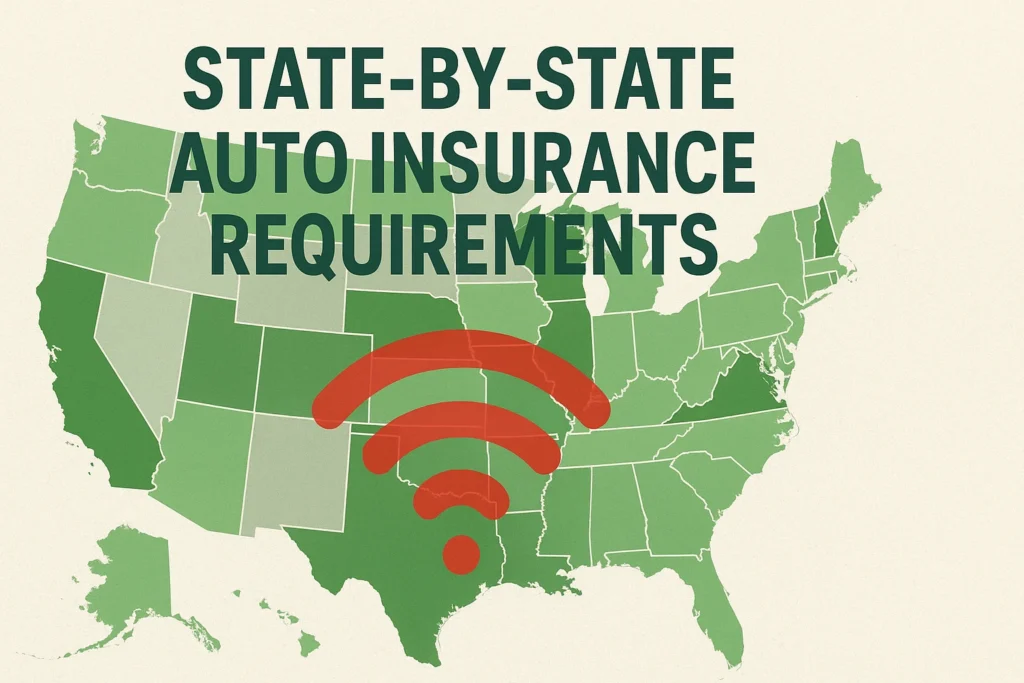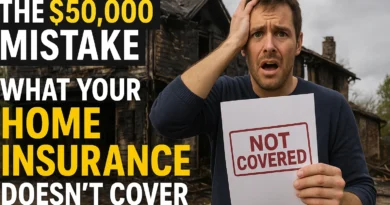State-by-State Auto Insurance Requirements: Complete Guide
If you’ve ever moved from one state to another, you’ve probably discovered that auto insurance isn’t a one-size-fits-all requirement across America. What’s perfectly legal coverage in Florida might leave you completely unprotected—and breaking the law—in Alaska. The differences aren’t just minor variations; they’re dramatic gaps that can cost you thousands of dollars and even land you in legal trouble.
In 2025, several states are implementing significant changes to their minimum insurance requirements, with California increasing from 15/30/5 to 30/60/15, North Carolina jumping to 50/100/50, Utah raising limits to 30/65/25, and Virginia moving to 50/100/25. But here’s what insurance companies don’t want you to know: even with these increases, most state minimums still leave drivers dangerously underinsured.
This complete guide will break down every state’s insurance requirements, reveal why these minimums are inadequate, and show you how to protect yourself without overpaying. Whether you’re shopping for new coverage, moving to a different state, or just want to ensure you’re properly protected, this comprehensive resource will save you from costly mistakes and legal troubles.
Understanding the Insurance Code: What Those Numbers Actually Mean
Before diving into state-by-state requirements, let’s decode the three-number system that determines your coverage. When you see numbers like “25/50/25,” here’s what they represent:
- First Number (25): Bodily injury liability per person – the maximum your insurance pays for one person’s injuries in an accident you cause
- Second Number (50): Bodily injury liability per accident – the total maximum for all people injured in a single accident
- Third Number (25): Property damage liability – the maximum for property damage you cause
So a 25/50/25 policy means up to $25,000 for one person’s injuries, $50,000 total for all injuries, and $25,000 for property damage. These limits represent thousands of dollars, so a 15/30/10 policy provides $15,000 per person for bodily injuries, but no more than $30,000 for the entire incident, plus $10,000 in property damage coverage.
2025’s Major Changes: States Raising the Bar
Four states are significantly increasing their minimum requirements in 2025, recognizing that decades-old limits no longer reflect modern accident costs:
California’s Historic Increase
California is implementing its first minimum coverage increase in 56 years, jumping from 15/30/5 to 30/60/15 effective January 1, 2025. This change affects nearly 40 million drivers and represents a doubling of most coverage limits. The changes won’t stop there—California minimum limits will rise again in 2035 to 50/100/25.
North Carolina’s Aggressive Approach
North Carolina is making the most dramatic change, increasing from 30/60/25 to 50/100/50 effective July 1, 2025, making it the state with the highest property damage minimum limit. This $50,000 property damage requirement reflects the reality of modern vehicle costs.
Utah and Virginia Follow Suit
Utah’s limits will increase to 30/65/25, while Virginia moves to 50/100/25, both effective January 1, 2025. These changes show a growing recognition that outdated minimums leave drivers financially vulnerable.
Complete State-by-State Requirements for 2025
Based on current data, here are the minimum insurance requirements for all 50 states and the District of Columbia:
High-Requirement States (Above Average Protection)
Alaska: 50/100/25
- No additional requirements
- At-fault state
- Higher limits reflect harsh weather risks and remote locations
Maine: 50/100/25 + UM/UIM 50/100 + MedPay $2,000
- Comprehensive requirements including medical payments
- At-fault state
- Cold weather and rural areas drive higher requirements
North Carolina: 30/60/25 (increasing to 50/100/50 in July 2025)
- Currently has uninsured motorist requirements
- At-fault state
- Will have highest property damage requirements in the nation
Virginia: 25/50/20 (increasing to 50/100/25 in January 2025)
- Recently eliminated uninsured motorist fee option
- At-fault state
- Major overhaul of insurance laws completed in 2024
Mid-Tier Requirement States (Moderate Protection)
Texas: 30/60/25
- Optional PIP coverage ($2,500 unless waived)
- At-fault state
- Higher limits reflect large population and expensive vehicles
California: 30/60/15 (increased January 1, 2025)
- No uninsured motorist requirement
- At-fault state
- First increase in 56 years, with another planned for 2035
Maryland: 30/60/15 + UM/UIM 30/60/15 + PIP $2,500
- Comprehensive no-fault benefits
- At-fault state
- Requires both uninsured motorist and PIP coverage
Illinois: 25/50/20 + UM/UIM 25/50
- Requires uninsured motorist coverage
- At-fault state
- Higher property damage limit than many states
Minimum Requirement States (Basic Protection)
Florida: 10/20/10 + PIP $10,000
- Among the lowest liability limits in the nation
- No-fault state
- Personal Injury Protection required but no bodily injury liability
Pennsylvania: 15/30/5 + PIP $5,000
- Extremely low limits
- No-fault state
- Optional limited tort/full tort election
Louisiana: 15/30/25
- Very low bodily injury limits
- At-fault state
- High property damage relative to bodily injury
No-Fault States (Different Rules Apply)
READ ALSO: Minimum Coverage vs Full Coverage: What Insurance Companies Don’t Tell You
These states require Personal Injury Protection (PIP) and operate under no-fault systems:
- Florida: 10/20/10 + PIP $10,000
- Hawaii: 20/40/10 + PIP $10,000
- Kansas: 25/50/25 + UM/UIM 25/50 + PIP $4,500
- Kentucky: 25/50/25 + UM/UIM 25/50 + PIP $10,000
- Massachusetts: 20/40/5 + UM/UIM 20/40 + PIP $8,000
- Michigan: 50/100/10 + PIP (tiered options)
- Minnesota: 30/60/10 + UM/UIM 25/50 + PIP $40,000
- New Jersey: 25/50/25 + UM/UIM 25/50 + PIP $15,000
- New York: 25/50/10 + UM/UIM 25/50 + PIP $50,000
- North Dakota: 25/50/25 + UM/UIM 25/50 + PIP $30,000
- Utah: 30/65/25 (increased January 1, 2025) + PIP $3,000
States Without Mandatory Insurance
New Hampshire: 25/50/25 (if unable to prove financial responsibility)
- The only state that doesn’t require car insurance if you can prove financial responsibility
- Must demonstrate ability to pay for damages
- Can be required to carry insurance after violations
The Hidden Costs of Minimum Coverage by Region
High-Cost Coastal Areas
States like California, New York, and Florida have some of the highest accident costs in the nation, yet several maintain relatively low minimum requirements:
Average accident costs in major metropolitan areas:
- Los Angeles: $67,000 average serious injury claim
- New York City: $78,000 average serious injury claim
- Miami: $52,000 average serious injury claim
State minimums in these areas:
- California: $30,000 per person (barely half of average claim)
- New York: $25,000 per person (less than one-third of average claim)
- Florida: $0 bodily injury requirement (complete exposure)
Weather-Risk States
States prone to severe weather often see higher comprehensive and collision claims, but this doesn’t always translate to higher liability requirements:
Hail-prone states with low minimums:
- Texas: 30/60/25 (better than most)
- Oklahoma: 25/50/25 (moderate)
- Colorado: 25/50/15 (low property damage)
- Kansas: 25/50/25 + additional requirements
High Rural-Risk States
Rural states often have higher fatality rates due to remote locations and delayed emergency response, yet many maintain low minimums:
Rural states with concerning minimums:
- Wyoming: 25/50/20
- Montana: 25/50/20
- South Dakota: 25/50/25
- North Dakota: 25/50/25 (but includes PIP)
Why State Minimums Are Dangerously Inadequate
State minimum requirements are not adjusted for years at a time and may not be high enough to fully cover you if you’re responsible for a collision. Here’s the reality of why minimum coverage is insufficient:
Medical Cost Inflation
Since most state minimums were last updated:
- Emergency room costs have increased 176%
- Ambulance costs have increased 145%
- Surgical procedures have increased 89%
- Physical therapy costs have increased 134%
Modern Vehicle Technology Costs
Today’s vehicles contain expensive technology that dramatically increases repair costs:
- Average vehicle repair cost: $4,700 (up 38% from 2020)
- Luxury vehicle average repair: $8,900
- Electric vehicle average repair: $6,200
- Advanced driver assistance system recalibration: $1,200-$3,500 per accident
Legal Settlement Trends
Courts and juries are awarding larger settlements:
- Pain and suffering awards have increased 67% since 2015
- Lost wage calculations now include longer recovery periods
- Punitive damages are more common in severe cases
Special Considerations by State Type
Tourist Destination States
States with high tourist populations face unique insurance challenges:
Florida Considerations:
- High uninsured driver rate (20%+)
- Expensive rental cars involved in accidents
- Mix of inexperienced local geography drivers
Hawaii Considerations:
- Extremely high vehicle costs due to shipping
- Limited repair facilities increase costs
- Tourist rental car complications
Nevada (Las Vegas) Considerations:
- High concentration of expensive vehicles
- Tourist-related accidents with out-of-state drivers
- Entertainment district accident complications
Border States
States on international borders face unique risks:
Texas-Mexico Border:
- Complicated cross-border accident investigations
- Currency conversion issues in settlements
- Different insurance verification systems
Northern Border States:
- Canadian driver accident complications
- Weather-related cross-border issues
- Different insurance company recognition
High-Net-Worth Areas
Certain states have concentrations of high-net-worth individuals that increase lawsuit exposure:
Connecticut, New Jersey, New York:
- Higher average lawsuit settlements
- More expensive vehicles on roads
- Greater personal asset exposure for defendants
Industry Secrets About State Requirements
Why Some States Keep Requirements Low
Insurance companies and state governments sometimes have conflicting interests regarding minimum requirements:
Insurance Company Preferences:
- Lower requirements = lower claim payouts
- More customers can afford minimum policies
- Higher profit margins on inadequate coverage
State Government Considerations:
- Low requirements keep insurance “affordable”
- Fewer uninsured drivers (in theory)
- Political pressure to avoid mandating expensive coverage
The Federal vs. State Issue
Unlike health insurance, auto insurance has no federal minimum standards, leading to:
- Massive variations in protection levels
- Cross-state accident complications
- Inability for federal programs to address gaps
The Uninsured Driver Connection
States with very low requirements often have higher uninsured driver rates:
- Drivers choose to go uninsured rather than buy inadequate coverage
- Low minimums don’t provide enough protection to justify cost
- Enforcement becomes focused on having coverage rather than adequate coverage
How to Choose Appropriate Coverage in Your State
The Asset Protection Formula
Your liability coverage should protect your assets and future income:
- Calculate Net Worth: Home equity + savings + investments + retirement accounts
- Add Future Earnings: Annual income × years until retirement × 0.5
- Add Safety Buffer: 25-50% above total
- Compare to State Minimum: Usually 5-10 times higher than required
Regional Risk Adjustments
Adjust your coverage based on local factors:
High-Cost Areas: Increase all limits by 50-100% Weather-Risk Areas: Emphasize comprehensive coverage High-Crime Areas: Add theft protection and consider gap coverage Tourist Areas: Increase property damage limits for expensive rental cars
No-Fault State Considerations
In no-fault states, prioritize:
- Higher PIP/MedPay limits
- Strong uninsured motorist coverage
- Adequate property damage for vehicle replacement
The Real Cost of Compliance vs. Protection
Minimum Coverage Costs
A liability-only policy averages $44 per month with top providers like Geico and State Farm, but this is false economy:
Annual minimum coverage: $528 Estimated out-of-pocket risk: $15,000-$50,000 Total risk exposure: $15,528-$50,528
Adequate Coverage Costs
Annual adequate coverage: $1,200-$1,800 Estimated out-of-pocket risk: $1,000-$3,000
Total risk exposure: $2,200-$4,800
The “expensive” adequate coverage actually reduces your total financial risk by $13,000-$45,000 annually.
Moving Between States: What You Need to Know
Grace Periods
Most states give new residents 30-90 days to comply with local requirements:
- Update your policy immediately upon moving
- Don’t wait for renewal periods
- Some states require immediate compliance
Registration Requirements
You cannot register a vehicle without meeting state minimums:
- Bring proof of coverage to DMV
- Policy must show state-compliant limits
- Some states verify coverage electronically
Cross-State Accident Complications
Different state requirements can create problems:
- Your home state minimums may not be adequate in accident state
- Some states have different fault determination rules
- Settlement processes vary significantly
2025 Trends and Future Changes
States Considering Increases
Beyond the four states implementing changes in 2025, several others are studying increases:
- Arizona: Reviewing 25/50/15 requirements
- Georgia: Committee studying outdated 25/50/25 limits
- Ohio: Insurance department recommending increases
- Tennessee: Legislative discussions about 25/50/15 inadequacy
Technology-Driven Changes
Future requirements may address:
- Electric vehicle repair costs
- Advanced driver assistance system complications
- Autonomous vehicle transition issues
- Telematics and usage-based considerations
Federal Intervention Possibilities
Some experts predict eventual federal minimum standards due to:
- Interstate commerce complications
- Inadequate state-by-state protection
- Insurance industry consolidation
- Cross-border accident difficulties
Red Flags That Indicate You Need More Than Minimums
Personal Financial Red Flags
- You own a home with equity
- You have significant savings or investments
- Your annual income exceeds $50,000
- You have substantial retirement accounts
- You support dependents financially
Driving-Related Red Flags
- You commute in heavy traffic
- You frequently drive in expensive vehicle areas
- Your car is financed or leased
- You often carry passengers
- You drive for business purposes
Geographic Red Flags
- You live in a high-cost metropolitan area
- Your area has severe weather risks
- Local average incomes are high
- Tourist traffic is heavy in your area
- Uninsured driver rates are high locally
Taking Action: Your State-by-State Strategy
Research Phase
- Verify Current Requirements: State DMV websites have updated information
- Check for Pending Changes: Insurance department announcements
- Research Local Costs: Average accident costs in your specific area
- Calculate Your Needs: Asset protection formula customized to your situation
Shopping Phase
- Get Multiple Quotes: At least 5 companies with identical coverage
- Compare Beyond Price: Claims service reputation and financial strength
- Consider Local Factors: Regional insurers may offer better value
- Factor in Discounts: Long-term savings vs. immediate low prices
Purchase Phase
- Exceed State Minimums: Generally by 300-500% for adequate protection
- Bundle Strategically: Home/auto combinations often provide better coverage
- Review Annually: Requirements change and your needs evolve
- Document Everything: Keep proof of coverage easily accessible
The Bottom Line: State Requirements vs. Real Protection
State minimum insurance requirements are legal compliance tools, not financial protection strategies. All U.S. states except New Hampshire require drivers to have a minimum amount of liability car insurance, but keep in mind these limits are not adjusted for years at a time and may not be high enough to cover you fully if you’re responsible for a collision.
The 2025 increases in California, North Carolina, Utah, and Virginia represent long-overdue acknowledgments that decades-old minimums don’t reflect modern accident costs. However, even these increased limits may not provide adequate protection for many drivers.
Your insurance decision should be based on:
- Legal compliance – meeting your state’s minimum requirements
- Asset protection – covering your wealth and future income
- Peace of mind – knowing you’re protected against financial catastrophe
- Cost optimization – getting the best value, not the lowest price
Remember that insurance is the only product you buy hoping you’ll never need to use it. When you do need it, you want it to actually work. Don’t let artificially low state minimums fool you into thinking you’re protected when you’re really exposed to significant financial risk.
The few extra dollars you spend on adequate coverage could save you from bankruptcy, foreclosure, or decades of financial recovery from a single accident. That’s not insurance—that’s financial security. Choose coverage that actually protects you, not just coverage that keeps you legal.
State requirements are the floor, not the ceiling. Build your protection from there, and you’ll never regret having too much coverage when you need your insurance to work for you.
In another related article, Why Your Auto Insurance Just Went Up (And How to Fight Back)





